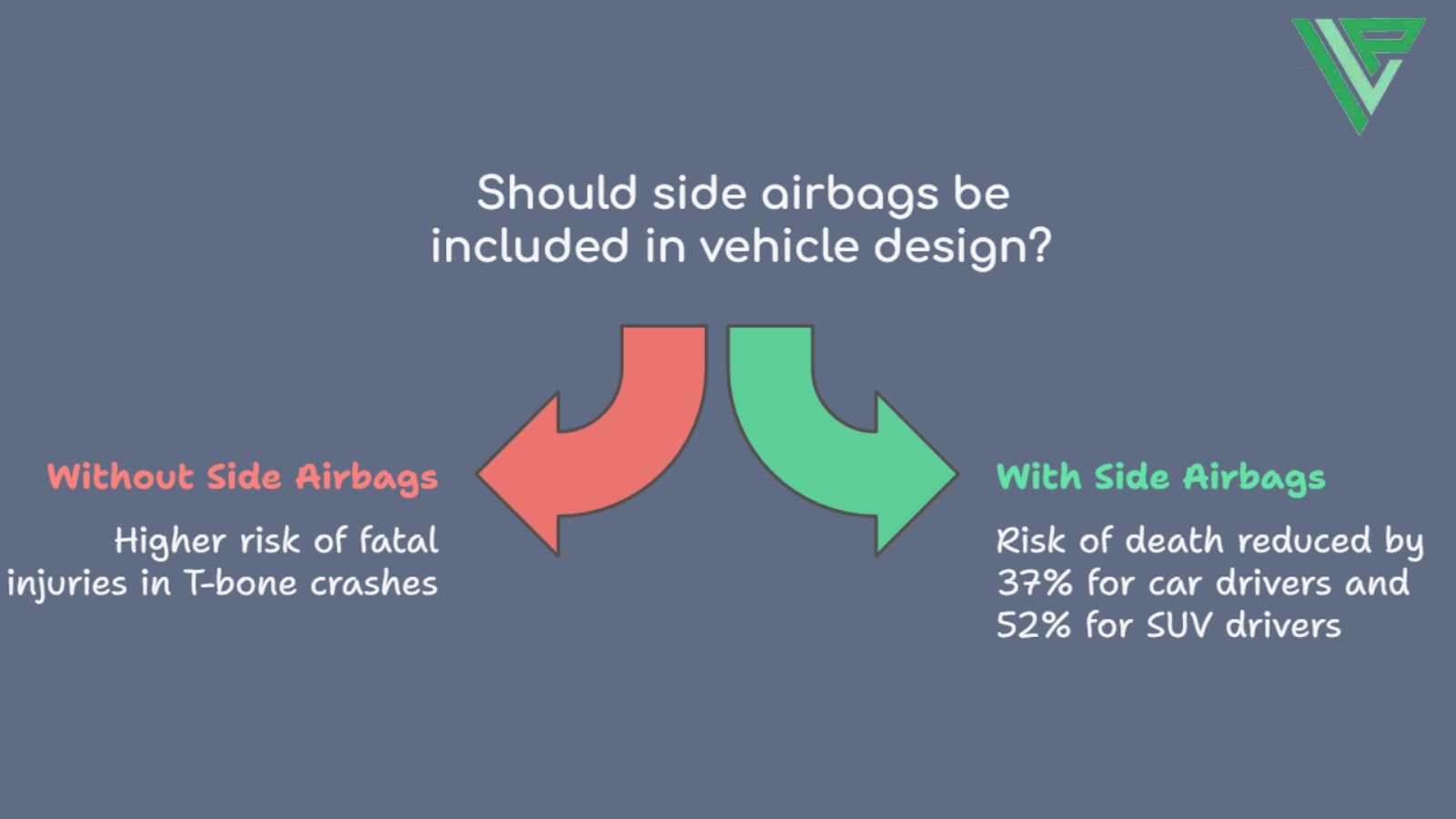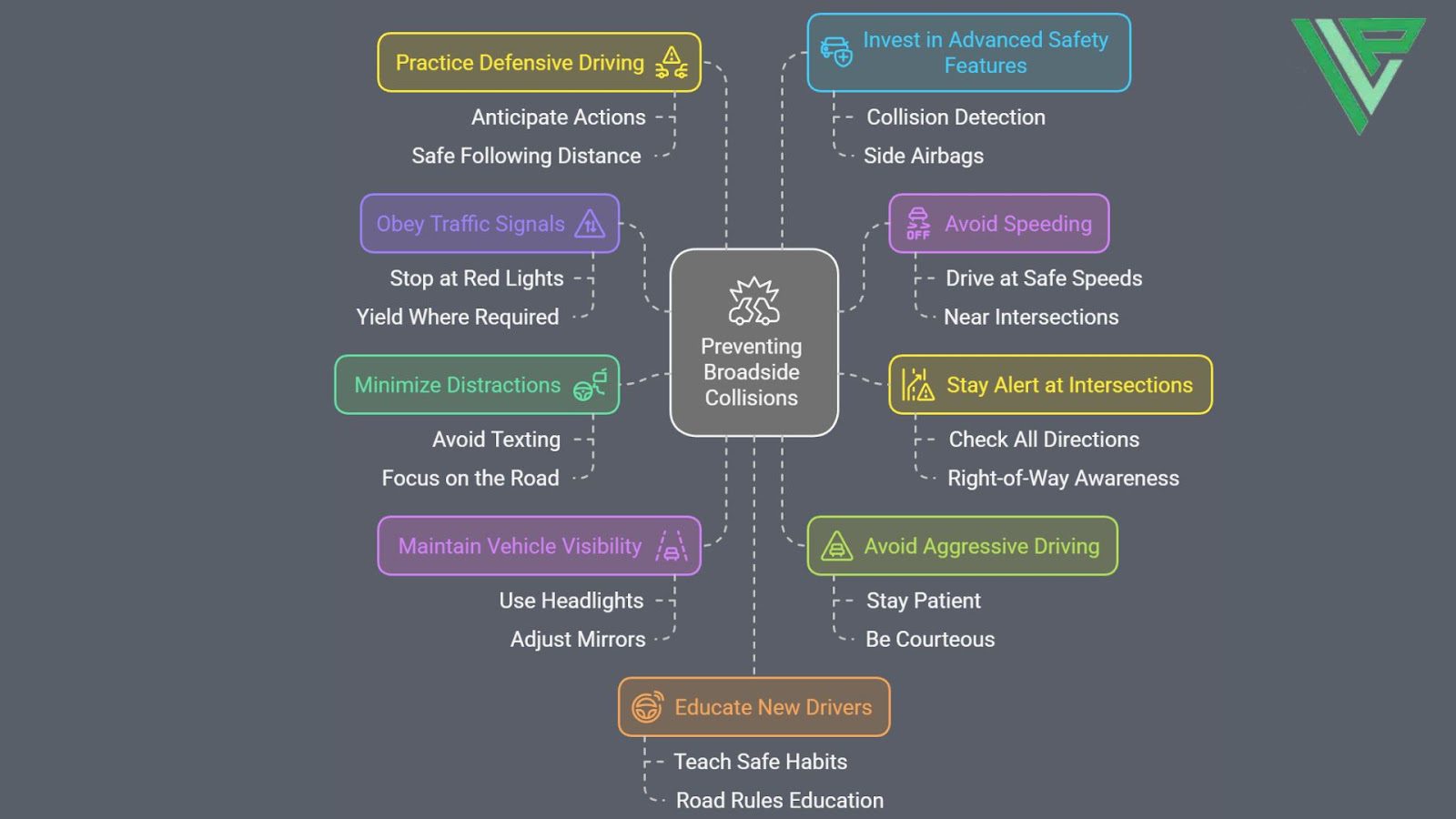Broadside collisions are one of the most devastating crashes on the road, leading to severe injuries and significant damage. These accidents often leave victims overwhelmed with medical bills and lost wages.
According to the National Highway Traffic Safety Administration (NHTSA), broadside collisions account for 23% of all vehicle occupant fatalities in multi-vehicle crashes.
At Injury Law Pros, we not only fight for you and your fair compensation but also make sure that your payout is always more than our fees—guaranteed.
Key Takeaways
- A broadside collision, or T-bone accident, involves one vehicle’s front striking another’s side, often causing severe damage and injuries.
- Common causes include running red lights, failure to yield, distracted driving, limited visibility, and driving under influence.
- Primary sites for these accidents are intersections, parking lots, driveways, high-speed roads, urban roads, and rural roads.
- Preventative measures include driver education, public awareness campaigns, DUI prevention strategies, regular vehicle maintenance, and defensive driving practices.
- Post-collision, prioritize immediate safety, document accident scene, consult legal aid for claims, and consider potential damages for medical expenses, lost wages, and pain.
What is a Broadside Collision?
A broadside collision, often referred to as a T-bone accident, occurs when the front of one vehicle directly strikes the side of another, forming a “T” shape at the point of impact.
Broadly defined, this type of incident typically results in significant vehicle damage and potential injury. The broadside definition emphasizes the angle of the collision, an aspect essential to understanding its consequences.
What Are The Common Causes of Broadside Collisions?
Broadside collisions often occur due to specific driver behaviors or conditions. Here are the main causes of a broadside collision, which can lead to potential severe injuries and damage:
Driver Runs Stop Sign/Red Light
While many factors can contribute to broadside collisions, one of the most common causes is when a driver runs a stop sign or red light. This traffic violation, often referred to as running signals, can result in unexpected and severe impact as the offending vehicle collides with the side of another.
The common causes of running a stop sign or light include:
- Distraction: Distracted driving is a major factor leading to running signals. Texting, eating, or using navigation systems can divert a driver’s attention.
- Impatience: Some drivers, in an attempt to save time, deliberately ignore traffic signals, putting others at risk.
- Poor visibility: Inadequate lighting or weather conditions can make it difficult to see traffic signals.
- Malfunctioning signals: Occasionally, traffic signals may malfunction, leading to confusion and potential collisions.
Failure to Yield
Another leading cause of broadside collisions is the failure to yield. This violation happens when a driver neglects their responsibility to give way at intersections or when merging lanes.
Various failure scenarios arise, typically where there’s confusion over right-of-way rules.The legal implications of this are serious, as it can result in fines, penalties, or even criminal charges in severe cases.
Additionally, it leaves the non-yielding driver liable for any damages or injuries caused by the collision. It’s essential for drivers to understand the importance of yielding, not just for their safety but also for the wellbeing of others on the road.
Proper education and adherence to traffic rules can greatly reduce the occurrence of these avoidable accidents.
Driving Under the Influence
Despite being illegal and widely recognized as dangerous, driving under the influence (DUI) remains a common cause of broadside collisions.
DUI penalties serve as a significant deterrent, with consequences ranging from hefty fines and license suspension to imprisonment. However, these punitive measures are often insufficient to eliminate the problem entirely.
DUI prevention strategies are essential. These can include educational programs, increased law enforcement visibility, and the use of breathalyzer ignition interlock devices.
Distracted Driving

Distracted driving emerges as another significant contributor to broadside collisions. Often, these distractions stem from mobile phone usage, eating, grooming, or even adjusting the radio.
Despite the enactment of distracted driving laws, complacency continues to undermine road safety. The effects of distractions are profound, leading to slower reaction times, impaired decision-making, and ultimately, collisions.
The severity of broadside collisions often results in severe injuries or fatalities, making the need for preventative measures more urgent. Understanding the dangers of distracted driving and respecting the laws designed to curb it are vital steps every driver must take.
Limited Visibility or Blind Spots
Limited visibility or blind spots greatly contribute to broadside collisions. These situations occur when drivers fail to observe or misjudge the presence of an approaching vehicle due to obstructed views. This blind spot awareness is essential in preventing broadside collisions.
It is vital to remember the following preventative measures to overcome limited visibility:
- Vehicle Design: Some vehicles have larger blind spots than others. Understanding your vehicle’s blind spots is important for visibility enhancement.
- Mirrors: Improperly adjusted mirrors can create blind spots. Regularly check and adjust your mirrors correctly.
- Weather Conditions: Poor weather can limit visibility and create temporary blind spots.
- Nighttime Driving: Limited light can create blind spots or areas of low visibility.
Aggressive Driving or Road Rage
Aggressive driving or road rage emerges as another significant contributor to broadside collisions. These hostile behaviors often manifest in excessive speeding, abrupt lane changes, and failing to yield right of way, all of which increase the likelihood of such accidents.
To enhance road safety, thorough driver education that focuses on the dangers of aggressive driving and road rage is imperative. This would equip drivers with the necessary knowledge and skills to anticipate and avoid potential hazards, reducing the occurrence of broadside collisions.
Where do Broadside Collisions Happen?
Broadside collisions frequently occur in specific types of locations due to their unique traffic dynamics. These include intersections, parking lots, driveways, and private roads, where visibility can be compromised; and high-speed roads, where the force of impact can be magnified.
Intersections
Often, the most perilous locations for drivers are intersections, being the primary setting for broadside collisions. The Federal Highway Administration reports that more than 50% of fatal intersection crashes in the U.S. happen at intersections.
Traffic signals serve as the lifeline of intersection safety, dictating the right of way. Ignore them, and you put yourself and others at risk. Turning without proper signaling can lead to broadsides, as oncoming traffic may not anticipate your move.
Parking Lots
Parking lots are another common location where these accidents occur. The design of parking lots, with multiple vehicles moving in different directions, often creates an environment conducive to broadside collisions.
| Parking Lot Areas | Collision Risk | Prevention Strategy |
| Parking Aisles | High | Slow down, observe traffic |
| Parking Stalls | Medium | Check mirrors before pulling out |
| Entrances/Exits | High | Yield to oncoming traffic |
Parking lot safety measures, such as adherence to speed limits, right of way and use of indicators, can greatly contribute to collision prevention. Further, being aware of other drivers’ actions and maintaining a safe distance from other vehicles can also help reduce the risk of broadside collisions in parking lots.
Driveways and Private Roads
Despite their seemingly safe and controlled environments, driveways and private roads are not exempt from the occurrence of broadside collisions. They often occur under the following circumstances:
- Limited Visibility: Trees, fences, and curves can obstruct a driver’s view, increasing the chances of broadside collisions.
- Unexpected Traffic: Pedestrians, bicyclists, or other vehicles could suddenly appear, leading to emergency braking or swerves.
- Speeding: Although private roads seem secluded, excessive speed can lead to severe accidents.
- Distraction: Home proximity might induce a false sense of security, causing drivers to engage in distractions like phone use.
Understanding these risks helps foster a safer driving culture, minimizing the potential for broadside collisions in these locations.
High-Speed Roads
High-speed roads are another common site for broadside collisions. These occur when drivers fail to manage high-speed impacts effectively, resulting in severe consequences for road safety.
Consider the following statistical data:
| Road Type | Broadside Collisions | Fatalities |
| Highways | 35% | 30% |
| Urban Roads | 25% | 20% |
| Rural Roads | 40% | 50% |
What Injuries Can Occur From Broadside Collisions
The impact of these collisions can lead to a range of injuries, from fractures and internal injuries to traumatic brain injuries, contingent on factors such as speed and safety features.The potential injuries resulting from broadside collisions can be severe, given the minimal protection offered by the sides of vehicles.
Role of Airbags in Broadside Collisions

Given the protective function of airbags in automotive collisions, understanding their role in broadside accidents is vital. Airbags serve to absorb the impact force, markedly reducing the risk of severe injuries.
- Airbag Effectiveness: Airbags reduce injury severity by preventing direct collisions with the car’s interior. Nonetheless, their effectiveness in broadside collisions is sometimes limited due to the sudden lateral impact.
- Safety Regulations: These mandate the inclusion of side airbags in vehicles, which are essential during broadside collisions.
- Timely Deployment: The airbag’s effectiveness depends on its timely deployment. A slight delay can result in serious consequences.
- Maintenance: Regular checks guarantee airbag readiness, thereby maintaining their effectiveness in the event of a broadside collision.
What to Do After a Broadside Collision?
Here’s what to do after a broadside collision:
- After experiencing a broadside collision, it is essential to prioritize your immediate safety and health.
- Alert the emergency response team as soon as possible, even if you feel fine; some injuries may not be immediately apparent.
- Next, inform your insurance company about the collision to initiate the claims process.
- Document the accident scene if it’s safe to do so; photographs, videos, and witness statements can provide vital evidence.
- Despite the emotional turmoil, try to remain calm and cooperate fully with law enforcement and emergency personnel.
- Finally, consult a legal professional to maneuver the ensuing intricacies.
These steps protect your wellbeing, rights, and interests in the aftermath of a broadside collision.
What Damages Can You Claim in Broadside Accidents?
Broadside accidents, often resulting in substantial damage and personal injury, can give rise to significant legal claims. Such damages may include, but are not limited to, medical bills, property damage, lost wages, and pain and suffering.
Medical Expenses
One of the essential responsibilities of a car accident lawyer in broadside collisions is to help clients claim medical expenses.
This includes:
- Analyzing medical treatment options to determine what costs should be covered.
- Negotiating with insurance companies to maximize coverage.
- Documenting all medical-related expenses for a thorough claim.
- Make sure all future medical needs arising from the accident are adequately compensated.
Lost Wages
A significant financial burden resulting from broadside collisions is lost wages. When an accident causes a victim to miss work, lost income can quickly accumulate. A car accident lawyer can play an essential role in securing financial recovery for these losses.
Property Damage
Broadside accidents often result in significant property damage, adding to the financial burden of the victims.
- Accurate property assessments are critical for claiming damages.
- Insurance claims must reflect the true extent of the damage.
- A car accident lawyer can help maneuver these claims.
- Legal assistance guarantees victims aren’t shortchanged by insurance companies.
Understanding these aspects can greatly aid victims in their recovery process.
Pain and Suffering
Steering through the aftermath of a broadside collision, victims often grapple with not only physical injuries but also the intangible toll of pain and suffering.This emotional distress, while difficult to quantify, is a valid component of compensation claims.
An experienced car accident lawyer can help victims articulate this suffering and guarantee it is factored into the calculation of a fair and all-encompassing settlement.
Loss of Consortium
Moving beyond the domain of physical injuries and emotional distress, another significant aspect of compensation claims after a broadside collision is the loss of consortium.
- Loss of consortium refers to the deprivation of the benefits of a family relationship due to injuries.
- It includes loss of companionship, affection, comfort, and sexual relations.
- The spouse of the injured person typically claims this.
- The degree of loss depends on the seriousness of the injuries and their impact on the relationship.
Rehabilitation Costs
While the immediate aftermath of a broadside collision often involves medical treatments and surgeries, a significant portion of the recovery process—and the accompanying costs—lies in rehabilitation.
Rehabilitation techniques are tailored to individual needs, further complicating cost calculations. The rehabilitation duration, influenced by the severity of injuries, can span weeks to years, escalating costs considerably. These expenses are claimable, and can be better understood with a car accident lawyer.
Punitive Damages
In addition to the tangible, immediate costs associated with broadside collisions, such as rehabilitation expenses, there’s another significant category of compensation that victims may be entitled to punitive damages.
- Punitive damages serve to penalize the offender and discourage reckless behavior.
- They are awarded in cases involving gross negligence or intentional misconduct.
- They are separate from compensatory damages meant to cover actual losses.
- The legal consequences of a broadside collision can include substantial punitive damages.
How to Prevent Broadside Collisions

Despite the high incidence of broadside collisions, numerous strategies can be employed to mitigate their occurrence.
Safety tips include maintaining vigilance at intersections, as these are hotspots for such collisions. Increased driver awareness, particularly of the right-of-way rules, can notably reduce risks.
Being cautious even with green traffic signals, and making it a practice to look both ways before crossing an intersection, can potentially avert a broadside collision. Each driver’s commitment to these preventive measures is a service to all road users, promoting overall safety.
Get the Support You Deserve
At Injury Law Pros, we know how stressful dealing with the aftermath of a broadside collision can be, from medical bills to pursuing your rightful compensation. If you’ve been in a T-bone accident, our multilingual team is ready to provide clear, fair, and skilled legal support.
Take the first step toward justice—visit our contact page today, and let us help you secure the compensation you deserve.

